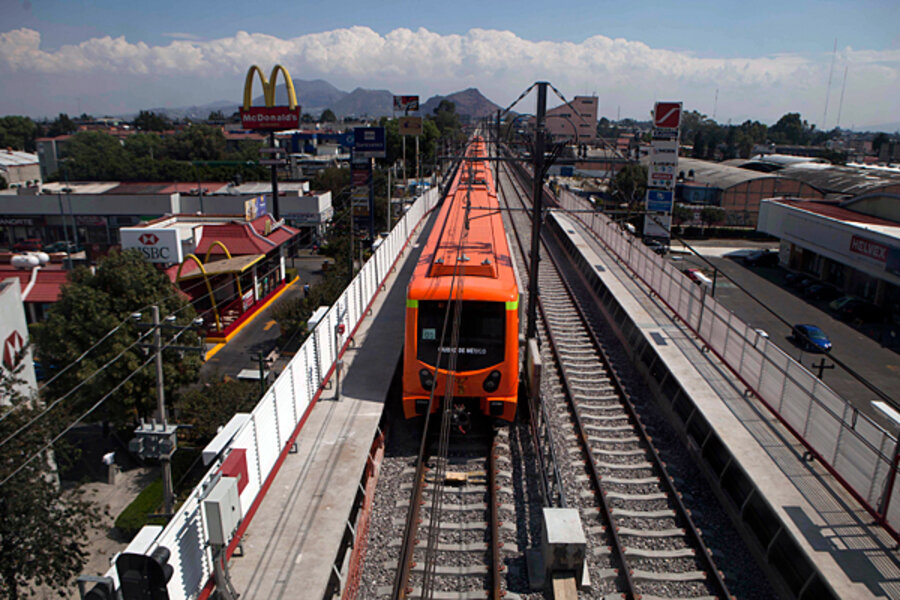Mexico City's new subway line to cut down on commute, pollution
Loading...
| Mexico City
For hundreds of thousands of Mexico City residents, daily life grew less arduous and less expensive Tuesday with the inauguration of a new subway line that reaches deep into poor districts of one of the world’s biggest metropolises.
The mostly underground line, which cost nearly $2 billion to build, will shave average daily commute times from about 150 minutes to 78 minutes for riders who take the speedy train. The reduction in time comes from taking riders off buses that crawl along congested streets.
“The importance of returning an hour of their day to people to use as they please is probably one of the greatest social and personal impacts of a project like this,” President Felipe Calderon said.
The project also is expected to help improve the capital’s air quality, by eliminating 860 buses from the city’s streets.
The new line, President Calderon said, “means a massive reduction” in vehicle traffic: “It is estimated that we’ll save 22,000 tons a year of carbon dioxide emissions with this mass transit project.”
Calderon called the completion of the 16-mile line “an engineering feat that competes with the best in the world.”
RELATED: How much do you know about Mexico? Take our quiz and find out!
Mexico City’s Metro, as the subway system is called, transports an average of more than 5 million people a day over about 110 miles of track, stopping at any of 195 stations. It’s one of the most heavily used systems in the world, rivaling New York’s subway for carrying the most commuters in the Western Hemisphere.
For the next six days, the newly inaugurated Line 12 (or the Gold Line) will carry commuters for free, drawing larger-than-usual ridership.
The usual Metro fare is three pesos, or slightly less than 25 U.S. cents.
Even paying the daily Metro fare, commuters in Mexico City’s largely poor southeastern quadrant will save considerable money – about $1 a day – by using the new line rather than taking multiple buses to reach their downtown destinations. Minimum wage in Mexico City is 62.3 pesos a day – about $4.80 – and many in the southeast quadrant don’t have formal jobs and might earn even less than that.
City officials say they expect 367,000 passengers to ride the new line daily in upcoming months, and that ridership will climb to about 460,000 people a day.
The project proved to be complex. A consortium led by Mexican engineers drilled through nine different types of soil and used special steel pillars on an elevated section to deal with the earthquake risk.
The project also has other benefits, some of them intangible. A state-of-the-art closed-circuit monitoring system means that passengers are likely to suffer fewer assaults and robberies than they do on buses. Experts say it may bring greater development to poorer districts traversed by the line, such as Tlahuac, Milpa Alta, Xochimilco, and Iztapalapa.
It’s perhaps the last public-works project that Mexico City Mayor Marcelo Ebrard will inaugurate before he leaves office Dec. 5, ending a six-year term that’s elevated his political stature.
Mr. Ebrard fought early this year for the presidential nomination of the leftist Revolutionary Democratic Party but ceded to a more veteran politician, Andres Manuel Lopez Obrador, a perennial runner-up who came in second again in the July 1 vote. Ebrard is considered a likely presidential candidate for the 2018 elections.
In addition to expanding the subway system, Ebrard has turned the capital’s largest ring road into a double-decker highway for much of its length, built a rapid transit system of articulated buses along four routes that sped commutes and cut pollution, and began a large bike-share system. The system, known as Ecobici, will have 4,000 bicycles in use scattered among 275 stations by the end of the year.
Users pay an annual fee of about $31 and can take bicycles for up to 45-minute periods as often as they wish.
RELATED: How much do you know about Mexico? Take our quiz and find out!







